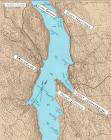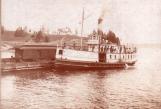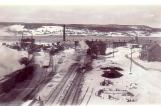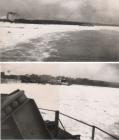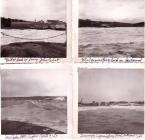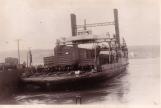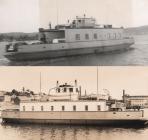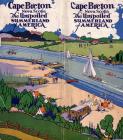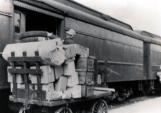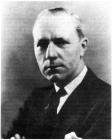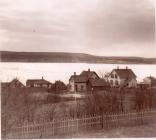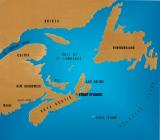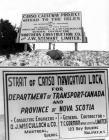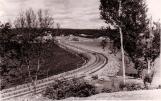

Gut of Canso Museum and Archives
Port Hastings, Nova Scotia
2
DREAM OF A PERMANENT CROSSING - The dream and necessity of a permanent crossing at the Strait of Canso between mainland Nova Scotia and Cape Breton Island was in the hearts and minds of Cape Bretoners for many years. This very deep waterway with swift running tides, winds blowing fiercely down through the Strait and huge ice floes in winter, had always made it a challenge to cross from the time of the earliest settlement in the 1780's.4
RAILROAD ARRIVES AT STRAIT OF CANSO - In 1880, the Intercolonial Railway arrived at Mulgrave on the mainland side of the Strait of Canso and in 1890, the railroad finally arrived on Cape Breton Island. The line was built between Point Tupper at the Strait of Canso and Sydney at the other end of the Island and by 1901, it was through to Inverness.The S.S. Norweigan followed by the S.S. Mulgrave had the task of ferrying the train cars across the Strait. The S.S. Mulgrave looked like a passenger boat. The train cars would go aboard tracks on a scow then the Mulgrave would hook onto the side of the scow and tow it across to the other side of the Strait. It was a precarious task and in winter a dangerous one.
6
FIRST BRIDGE DESIGN - The Cape Breton coal mines were entering an era of development which ushered in the 20th century and many Cape Bretoners saw the need and wisdom of replacing the old fashioned ferry with a permanent crossing. In 1901, the Municipality of Victoria County made a resolution which recommended the construction of a bridge across the Strait of Canso.With the incorporation of the Canso Bridge Company in 1902 and the selection of a bridge design by Donkin and Waddell, a firm from Missouri, USA was brought in to conduct initial surveys at the Strait of Canso. This engineer's sketch shows the proposed bridge. With the American firm at the site, however, public support for the project lessened and eventually permission to construct the bridge was revoked.
8
TRAIN CROSSINGS STATISTICS - The railway yard and ferry dock at Point Tupper on Cape Breton Island was a busy spot. The trains coming from what was referred to as Industrial Cape Breton where the coal mines and steel plants were had to be taken apart and pushed onto and off the train ferries for their trip across the Strait of Canso to Mulgrave on the mainland side.The same procedure occurred in Mulgrave to ferry trains across to Cape Breton."The volume of railway traffic transported by ferry boats has steadily increased from 40,000 cars a year in 1920 to an average of 113,000 cars each year between 1946 and 1950...By 1960 the estimated traffic per year might reach 145,000 cars"(Dept. of Mines andTechnical Surveys Geographical Bulletin No. 3, 1953)
9
The Pont de Canseau crossing the Strait of Canso circa 19261926
Strait of Canso, Nova Scotia, Canada

10
EARLY AUTO FERRIES - The first automobile ferries, too light and thin hulled to take the blows of the ice, were tied up and overhauled during the winter. It was only after the heavier ferries were introduced that year round ferry service for automobiles was offered.J. Alvin West of Port Hawkesbury who worked on the auto ferries in the Strait of Canso from 1934 to 1955 told Ron Caplan of the Cape Breton's Magazine,"Sometimes you couldn't make a straight course right across. You'd have to go down around, watch the ice pans. ....Captains would go if it was fit to go. Sometimes they took chances. Just had to.... "
12
PORT HAWKESBURY WAS THE GATEWAY TO CAPE BRETON for all of the auto traffic crossing to Cape Breton Island by the 1920's. In 1939, a Tourist Information Bureau was located just up from the ferry dock. There were stores, hotels and service stations on Granville Street to provide for the visitors needs."The tourist industry is one of the brightest spots in the economy of the Island; it is vital for it to have good roads and highways and a good system of crossing the Strait......"Tourism" depends almost entirely on the means of crossing the Strait". (Dept. of Mines and Technical Surveys Geographical Bulletin No.3, 1953)
14
FERRY BOAT SERVICE OPERATED YEAR ROUND THOUGH ICE WAS A PROBLEM - The Strait of Canso separates Cape Breton Island from mainland Nova Scotia and links the Gulf of St. Lawrence with the Atlantic Ocean.... During the winter, the ice that forms in the Gulf of St. Lawrence is carried down by the current and lodges all around the coast. George's Bay is frozen over and the northern section of the Strait is covered by a solid bridge of ice. For the most part, from the middle of January until the third week of April ocean navigation is completely interrupted though ferry boat service is continued... South of Mulgrave and Port Hawkesbury, the ice moves in both directions according to tidal flow and has not much chance to form an ice bridge. This movement of ice cakes up and down the channel makes the navigation of ferry boats difficult."(Dept. of Mines and Technical Surveys,Geographical Bulletin, No. 3,1953)16
BREAK UP OF ICE BY APRIL - "Ice breaks up first in the Northumberland Strait and moves north westward between Prince Edward Island and the coast of Nova Scotia; then the ice in Georges Bay breaks up and moves first northward and then southward. On one day the whole bay might be clear, but on the next day might be covered over again by southward moving ice on alternate days. Usually the ice packs escape through the Strait of Canso........It is only in the third week of April that the Strait is definitely clear of ice and declared open to (general) navigation until the following January."(Dept. of Mines and Technical Surveys,Geographical Bulletin No.3,1953)18
TOPIC OF FIXED LINK - The topic was still discussed in Board of Trade meetings but the only progress was to add another train ferry, the Scotia II. The crossings and delays had increased at the Strait of Canso due to more productivity for war materials needed from Cape Breton's coal and steel industries. There was no real action between the wars but still a keen interest in Industrial Cape Breton for a permanent crossing at the Strait of Canso.20
TRAIN FERRIES DURING WORLD WARS - Already obsolete as a peace time transportation link, the Scotia ferries revealed their weakness even more during the First Great War,1914 - 1918 and World War II, 1939 -1945. The delays of getting coal from Glace Bay, Sydney Mines and New Waterford, and steel from Sydney needed by the industrialists in Upper Canada for the war effort across the Strait of Canso bottleneck was a major problem. There was also a genuine concern that the Scotias might be sunk by German submarines in the Strait.21
Ice in Strait of Canso.. ferry approaching Port Hawkesbury.1950
Strait of Canso, Nova Scotia, Canada
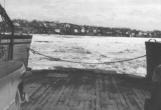
22
LOOKING FOR SOLUTIONS ICE CONDITIONS RECORDED IN 1941- The problem of huge ice and strong tides in the Strait of Canso was an issue to those responsible for getting people and products across the Strait of Canso. According to an Engineer's Field Book (dated between March 24 and April 24, 1941, found at the Gut of Canso Museum and Archives), ice conditions at the Point Tupper ferry dock and at the proposed site for a motor car ferry at Embree's Point were recorded and pictures taken.Poor weather conditions sometimes completely shut down the ferries due to ice or tides or both.
24
A STRONG ORGANIZATION WAS NEEDED - The Canso Crossing Association was formed in 1948, when the Associated Boards of Trade and other groups lobbying for a link at the Strait of Canso pooled their resources and decided to take a unified approach. "The Association's principle aim is to impress on the appropriate federal authority the necessity for either a bridge, a causeway or a tunnel across the Strait of Canso, N.S." (Dec. 23rd,1948 A Permanent Crossing over the Strait of Canso)Executive from left, seated: T.J. Currie, Ed Corbett, M.R. Chappell, W.D. Carmichael and W.S. Wilson. Standing: George O. Fraser, John C. MacMillan, Russell Urquhart, Johnston Chew, Rev. George MacLean, Gordon Elman, James G. Hackett and L.J. Doucet. Executive members not shown: Freeman Jenkins, I.N. MacLean, John. C. Holder, Tom McLachlan, Dr. Donald J. MacNeil, Dr. H.J. Devereau, Bert MacLeod, Sid Oram and H.D. Adamson.
26
CANSO CAUSEWAY ASSOCIATIONINDUSTRIAL CAPE BRETONERS ORGANIZED - Comprised of elements from several groups, most of which, if not all, were in the Industrial Cape Breton area, The Canso Crossing Assocation was formed as a non political, impartial pressure group. "It is the Association's purpose to lead and co ordinate the efforts of all those sympathetic to this project as a paramount factor in developing freer trade, in the advancement of industry, the promotion of employment and the establishment of better understanding between the people of Cape Breton and their fellow Canadians". (A Permanent Crossing over the Strait of Canso, Dec.23rd, 1948 )
The Canso Crossing Association handled all correspondence with the government from the point of its inception. Between the time of its creation in 1948 and February 1949 when the appointed board of engineers finished their study, the Canso Crossing Association took care of electing a board and launching a public relations campaign.
28
THE "BOCHAN" BRIDGE OF CANSO - Cape Bretoners had heard the promises so often of a bridge across the Strait of Canso that a poem was written with the above title... bochan being the Gaelic word for ghost. A newspaper account from August 31,1949, explains: "The job of boring at the site of the Strait of Canso bridge, the important preliminary step in the bridge project, is expected to be completed in the next 48 hours, it was indicated today. "Boring on Number Three Pier, the last of the eight borings, is still in progress by the Maritime Foundation Company, Montreal, contractors in charge of this undertaking...Superintendent in charge is Mr. Dinkler who is regarded as a top man in this particular work..."During preliminary tests on the site, it was decided that the bridge deck would need to be wider than the plans specified and without a complete redesign this could not be done. Plans for the bridge were scrapped in the early '50s due to concerns over safety.
Behind the scow is Cape Porcupine, three years before the first of over ten million tons would be blasted from its face to construct the Canso Causeway.
31
BEGINNING OF TOURISM INDUSTRY - By 1927, the Nova Scotia government was trying to attract more visitors to Cape Breton Island. They published a fifty page promotional book with this colourful cover. This would be the beginning of having to address tourists' needs to cross the Strait of Canso in a safe and reliable manner in much larger numbers.During WWII, due to restrictions on gasoline and difficult conditions of motoring, the traffic of automobiles varied between 22,000 and 28,000 vehicles a year; in 1946, 51,166 vehicles crossed the Strait and in 1949 more than 90,000. (NS Dept. of Highways and Public Works 1949 Annual Report)
33
BIRTH OF CAUSEWAY IDEA - No action may have taken place during the war years, but some people were well aware of the problems in crossing the Strait of Canso between Cape Breton Island and mainland Nova Scotia at Point Tupper and Mulgrave for the train ferries and Port Hawkesbury and Mulgrave for the car ferries.John R. MacIssac, the General Manager of Traffic and Transportation at Sydney's Dosco Steel Plant, fully appreciated the hazard on the Strait of Canso. He foresaw the threat of submarines along the coast and realized that several types of accidents or enemy actions could seriously impair or cripple Cape Breton's important contribution to the allied cause. He advocated and promoted a causeway in the general vicinity of Cape Porcupine that had tons of rock and Balhache Point (Port Hastings). His efforts did not bring the causeway but his contribution as a spokesman did much to popularize the type of crossing that later was built.
35
PERMANENT CROSSING WOULD MEAN JOB LOSS TO STRAIT AREA RESIDENTS - There wasn't any interest among the local people for a permanent crossing. There were too many who made their living on both sides of the Strait on the railroad and by transporting people and goods across the Strait.The 1951 census showed that the population of Cape Breton Island was 157,014. Sydney and the communities within an eighteen mile radius around it such as Glace Bay, New Waterford, Sydney Mines and North Sydney had a population of 83,000. The population of the larger communities in the Strait area was: Port Hawkesbury 1,034, Point Tupper 394 and Mulgrave 1,212 so the two hundred or more jobs to be lossed to the whole area would be devastating to residents of the Strait.
37
THE RIGHT MAN AT THE RIGHT TIME - Angus L. Macdonald was instrumental in getting a fixed link for the Strait of Canso area. He was the Premier of Nova Scotia from 1933 to 1940 and from 1945 to 1954. The five year period between was spent in Ottawa as a Minister of the war time cabinet. It was the determination of Angus L. combined with the resources of the Canso Crossing Association that saw the area's dream of a permanent crossing realized.L.J. Doucet, who served on the executive of the Canso Crossing Association, spoke of the leadership of Angus L. Macdonald and the role the Premier played in having the Causeway built in his book "Road to the Isle - The World's Deepest Causeway" published in 1955....
"It was during the period when the engineering opinion was consolidating itself behind a causeway that the late Honourable Angus L. Macdonald stood out as a man of diplomacy, resourcefulness and capacity. Without his fearless leadership and honesty and likewise without the Honourable Lionel Chevrier's desire to live up to his promises and committments, the Canso Project would still be an unattained dream..."
39
NO SENTEMENTAL JOURNEY: IT TOOK 23 HOURS - March 8, 1950 - The Cape Breton Post "A five-hour wait in Truro; five hours amid crunching ice floes in the Strait of Canso. Arrived at Sydney depot 23 hours after leaving Halifax.That was the log of the C.N.R. Express which arrived in Sydney from Halifax last night more than eight hours late. At 7 p.m. last night about 70 disgruntled passengers stepped off, looking forward to the day when the Canso Bridge would connect Cape Breton with the outside world, it has been thus for many years but yesterday's journey probably was one of the worst on record.
The train left Halifax at 9 p.m. Two hours later it arrived in Truro where it stood for five hours waiting for the Montreal carrier. But the payoff came at the Strait of Canso. The train arrived at the Strait shortly before dawn and then the shuffle started. The cars were transferred to the ferry which attempted a crossing. For two hours the craft bucked the heavy drift ice. The passengers became hungry and the ferry captain decided to turn back for Mulgrave. Here the travelers were taken to restaurants and private homes for a meal.
On the second trip, the ferry caught again and for three hours battled the ice which one railway official described as "the worst I have seen in many years."
The train reached Point Tupper at 3:30 p.m. and continued the journey to Sydney arriving shortly after 7 p.m. - 23 hours after leaving Halifax.
41
NEWFOUNDLAND JOINS CANADA - The Canso Causeway Association belaboured in their booklet published in December 1948 the significance of Newfoundland joining Canada in 1949 and raised the concern about the delays at the Strait of Canso.They also raised the increasing interest in 1949 on the country wide scale of the Trans Canada Highway being constructed and how it would cross the Strait of Canso. (Referring to the ferries) "Why not abolish such inadequate, uneconomic and sometimes dangerous obstructions? Wisdom suggests their replacement by a permanent crossing which should carry not only the Trans Canada Highway but also the tracks of the Canadian National Railways."(A Permanent Crossing over the Strait of Canso,Dec.23rd, 1948)
43
DREAM TO BECOME REALITY - In June of 1951, the Honourable Lionel Chevrier, Minister of Transport for the federal government, tabled a report in Ottawa which changed the recommendation of the Board of Engineers to go from a low level bridge to a causeway to join Cape Breton Island to Nova Scotia's mainland. The job of preparing the plans for the stone causeway and navigation locks was awarded to O.J. McCulloch Engineering Company of Montreal. In 1952, tenders were called and the 50 year dream of a fixed link from Cape Breton Island across the Strait of Canso to mainland Nova Scotia was official .Northern Construction and J.W. Stewart Limited began preparation at the Cape Porcupine construction site in Auld's Cove in July 1952.
